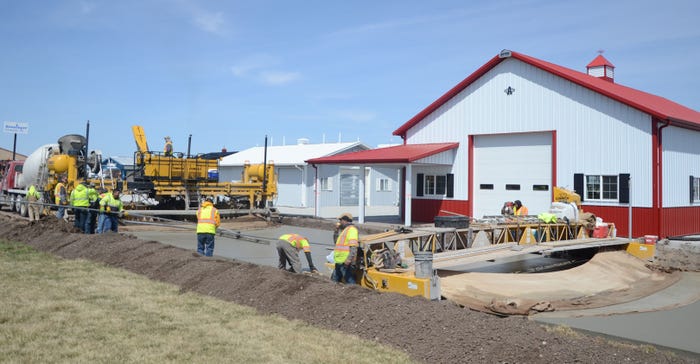
Husker Harvest Days won’t be here for another five months, but the streets of the show site west of Grand Island, Neb., are already busy.
Since November, crews have been working: laying groundwork, paving the streets, and putting in new electrical lines and transformers and a new drainage system as part of a $7.5 million upgrade to the HHD show site.
“Even when it was 15 [degrees F] below this winter, they never stopped working,” says Matt Jungmann, HHD show director.
Visitors and exhibitors at this year’s Husker Harvest Days will find themselves at a completely revamped show site. With that in mind, here’s a look of some of the new features visitors and exhibitors will notice at the show site this fall — and a few things you won’t see anymore.
What you’ll see
• Pavement. The most noticeable upgrade will be the paved streets – all 5.5 miles of them. The paved streets are being shaped with inverted crowns, directing rainwater to the drains in the center. In addition, concrete will be poured in all of the Diversified Industries buildings and the Livestock Building.
• Fencing. A 6-foot-tall perimeter fence will surround the exhibitors’ field. While most don’t see the site outside of the three days of HHD, the fence will provide after-hours security.
• New plumbing. The restroom at the middle of the site will be renovated and doubled in size, while a new restroom will be added on the south side of the grounds.
• Light towers. There will now be 90-foot-tall light poles with security lights, as well as PA speakers 40 feet off the ground. These light poles will also be equipped with Wi-Fi receivers at a taller height to improve internet distribution.
• Smoother traffic. A new entrance and exit will be added to the exhibitors’ parking lot to improve traffic flow on the south side of the show site.
“Where the shuttle buses used to come out of one gate, it’s hard for those big coach buses to swing into the show site. It slowed the flow down,” says Jungmann. “With one dedicated inbound and outbound for shuttle buses, it should make traffic flow a lot more smoothly.”
• New lot numbers and street names. With the expansion, street numbers will be flip-flopped. So, First Street becomes the northernmost street, and Tenth Street will be at the southern end of the site. Lot numbers will also be changed — although exhibitors will be in the same location they were in years past.
What you won’t see
• Muddy streets. The new pavement and drainage system will prevent rain from turning the HHD streets into a muddy mess. Originally, the site had about 8 inches of grade change from the west to the east; with the new drainage system, there are now 16 feet of change. Rain will collect in a new retention pond through drainage ditches near the visitors’ entrance. With the retention pond, drainage ditches and storm sewers, the site will have a total of 13 million gallons in water-holding capacity. With the upgrades, Jungmann notes the show site can handle a 4-inch rain.
“If 4 inches of rain somehow fell out of the sky at once, it would all go underground,” Jungmann says. “That’s not accounting for percolation into the soil.”
• Bridges. Now, exhibit lots will transition smoothly to the streets, so there will be no more bridges or jumping over standing water to get from a street to an exhibit.
• Dust-control trucks. Visitors likely remember trucks spraying water for dust control on dry, windy days at HHD. With the newly paved streets, these trucks will no longer be needed on the exhibitor field.
• Overhead utility lines. Overhead lines will be replaced by underground utility lines. With new, upgraded 75 kVA (kilovolt x amps) transformers, the show site’s electrical capacity will be tripled.
“What we’ve seen in the past when we’ve put this kind of commitment into the Farm Progress Show, we’ve seen exhibitors follow up and improve their exhibits to match the new infrastructure. Because we now have more capacity, we have better electricity distribution — they’re able to do more with their exhibits,” says Jungmann. “Before, exhibitors would put on the best show they could with the infrastructure available. We don’t want our infrastructure to be a limiting factor.”
About the Author(s)
You May Also Like








